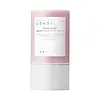What's inside
What's inside
 Key Ingredients
Key Ingredients

 Benefits
Benefits

 Concerns
Concerns

 Ingredients Side-by-side
Ingredients Side-by-side

Water
Skin ConditioningKaolin 8%
AbrasiveDipropylene Glycol
HumectantGlycerin
HumectantCI 77891
Cosmetic ColorantButylene Glycol
HumectantSodium Stearate
CleansingCentella Asiatica Extract 4.9%
Cleansing1,2-Hexanediol
Skin ConditioningPhaseolus Angularis Seed Powder
Aloe Barbadensis Leaf Extract
EmollientCetearyl Olivate
Propanediol
SolventSorbitan Olivate
EmulsifyingDimethicone
EmollientCI 77491
Cosmetic ColorantEthylhexylglycerin
Skin ConditioningSodium Phytate
Bentonite
AbsorbentIllite
AbrasiveMineral Salts
Skin ConditioningMontmorillonite
AbsorbentCalamine
AbsorbentWater, Kaolin 8%, Dipropylene Glycol, Glycerin, CI 77891, Butylene Glycol, Sodium Stearate, Centella Asiatica Extract 4.9%, 1,2-Hexanediol, Phaseolus Angularis Seed Powder, Aloe Barbadensis Leaf Extract, Cetearyl Olivate, Propanediol, Sorbitan Olivate, Dimethicone, CI 77491, Ethylhexylglycerin, Sodium Phytate, Bentonite, Illite, Mineral Salts, Montmorillonite, Calamine
Water
Skin ConditioningKaolin
AbrasiveTalc
AbrasiveButylene Glycol
HumectantBentonite
AbsorbentGlyceryl Stearate
EmollientCyclopentasiloxane
EmollientArgania Spinosa Kernel Oil
EmollientMentha Piperita Leaf Extract
Skin ConditioningHoney
HumectantHamamelis Virginiana Leaf Extract
Skin ConditioningCitrus Sinensis Peel Extract
PerfumingRoyal Jelly Extract
Skin ConditioningXanthan Gum
EmulsifyingCitric Acid
BufferingGlyceryl Stearate Se
EmulsifyingCeteth-20
CleansingPalmitic Acid
EmollientMineral Salts
Skin ConditioningMethicone
EmollientMoroccan Lava Clay
AbrasiveZinc Phosphate
Phenoxyethanol
PreservativeEthylparaben
PreservativeMethylparaben
PreservativeParfum
MaskingCI 77492
Cosmetic ColorantWater, Kaolin, Talc, Butylene Glycol, Bentonite, Glyceryl Stearate, Cyclopentasiloxane, Argania Spinosa Kernel Oil, Mentha Piperita Leaf Extract, Honey, Hamamelis Virginiana Leaf Extract, Citrus Sinensis Peel Extract, Royal Jelly Extract, Xanthan Gum, Citric Acid, Glyceryl Stearate Se, Ceteth-20, Palmitic Acid, Mineral Salts, Methicone, Moroccan Lava Clay, Zinc Phosphate, Phenoxyethanol, Ethylparaben, Methylparaben, Parfum, CI 77492
 Reviews
Reviews

Ingredients Explained
These ingredients are found in both products.
Ingredients higher up in an ingredient list are typically present in a larger amount.
Bentonite is an aluminium phyllosilicate clay with great absorbent properties. The name 'bentonite' comes from the area where the largest source is found: Fort Benton, Wyoming.
As a clay, bentonite is often used to absorb excess oil and provide exfoliation. It has also been shown to have some antibacterial and anti-inflammatory properties. Studies show bentonite was effective at calming dermatitis from poison ivy and in diaper dermatitis of infants. Bentonite has also been shown to act as a barrier against toxic compounds on your skin.
Sunscreens containing bentonite display higher water resistance and stay on the skin for much longer. The sunscreens containing bentonite also show higher potency and UV light absorbtion.
Bentonite is naturally created from volcanic ash and several natural weathering/hydrothermal processes.
A common usage of bentonite is removing excess protein from white wines. Bentonite contains a property of being able to absorb large amounts of protein from aqueous solutions.
Phyllosilicate clay has a structure formed by sheets.
Learn more about BentoniteButylene Glycol (or BG) is used within cosmetic products for a few different reasons:
Overall, Butylene Glycol is a safe and well-rounded ingredient that works well with other ingredients.
Though this ingredient works well with most skin types, some people with sensitive skin may experience a reaction such as allergic rashes, closed comedones, or itchiness.
Learn more about Butylene GlycolKaolin is a clay. It is used for oil control and to help minimize pores. Like other clays, kaolin has the ability to absorb excess sebum or oil. This can help clean out pores and mattify the skin.
Some types of kaolin may have exfoliating properties. When water is added to kaolin, it becomes a paste with small abrasive particles.
Most kaolin is a white color, but may be pink/orange/red depending on where it comes from.
The name 'kaolin' comes from a Chinese village named 'Gaoling'. Kaolin clay comes from rocks rich in kaolinite. Kaolinite, the mineral, has a silicate layered structure. Kaolinite is formed from chemical weathering of aluminum siilicate minerals.
Besides skincare, kaolin is commonly used to make glossy paper, in ceramics, toothpaste, and as medicine to soothe stomach issues.
Learn more about KaolinMineral Salts are salt (like the kind we eat) that contains minerals such as calcium or magnesium. Depending on the product, salt in skincare can be an abrasive, thickener, or preservative.
This ingredient may dry out the skin.
Water. It's the most common cosmetic ingredient of all. You'll usually see it at the top of ingredient lists, meaning that it makes up the largest part of the product.
So why is it so popular? Water most often acts as a solvent - this means that it helps dissolve other ingredients into the formulation.
You'll also recognize water as that liquid we all need to stay alive. If you see this, drink a glass of water. Stay hydrated!
Learn more about Water